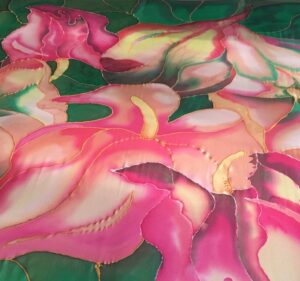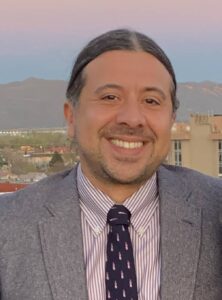May 2021: Jackie Pias Carlin

In May our nation recognizes the numerous contributions that generations of Asian Americans and Pacific Islanders have contributed to the diversity and vibrancy of our history, society and culture.
Asian American and Pacific Islander Heritage Month started as a concept in 1978 when the House and Senate presented joint resolutions to President Carter proposing that the first week in May be observed for such cultural recognition. In 1979 President Carter delivered Proclamation 4650 stating, “America’s greatness – its ideals, its system of government, its economy, its people – derives from the contributions of peoples of many origins…Asian-Americans have played a significant role in the creation of a dynamic and pluralistic America, with their enormous contributions to our science, arts, industry, government and commerce.”
In 1990 Congress expanded the observance to the entire month of May with President Bush adding, “A century and a half ago, many of these Americans contributed to the economic development of the United States through their labors on the plantations of Hawaii and in the mines of California. The important role played by many Asian and Pacific Americans in the building of the first transcontinental railroad is well documented.”
We are fortunate to have a state collection that includes Polynesian artifacts. This month’s Curator’s Corner highlights a Samoan tapa. Tapa is the common name for cloth made from the inner bark of trees which was often decorated and used for a variety of purposes, such as clothing, bedding, and floor coverings. The name for barkcloth varies throughout Polynesia; for example in Hawai’i it is kapa and in Samoa it is siapo.
Pacific Island tradition is nearer than you would imagine as we have the pleasure of an esteemed Maui cultural bearer living here among us in Carson City!
Together as Nevadans, let us study the past, honor the present, and envision the future.
This month, it is my pleasure to present… Jackie Pias Carlin!

Jackie Pias Carlin

The Artist in Maui, HI 1993/Carson City, NV 2019
Photos: Unknown/David Barrett
Almost all of my life I’ve been surrounded by sugarcane and the Pacific Ocean. My cultural heritage derives from the natives and the immigrants that together created a local culture from Hawaiian, Asian and European influences.
My interests in kapa-making started a long time ago, but the coveted process is long and difficult and takes patience. Much of the process today is from trail and error according to Kumu (teacher) Lisa Shattenberg-Raymond and Lei Ishikawa who shared their growing knowledge with us in kapa workshops at the Maui Nui Botanical Gardens. I learned a bit of how to prepare the wauke, the mulberry plant, and proceeded to plant them in our back yard and gathering berries for dyes from native farmers.
Away from the island’s resources, I adapted the kapa decorative ideas to the work I did on silk with French dyes. The kapa’s abstract designs come from Nature-flowers, mountains, ocean, sea urchins, stars, etc. My present designs come from island memories and what surrounds me here.
I work on flat surfaces, and I exaggerate the values of light and dark to bring hope and dimension to the fabric, paper, or canvas. I do this to give a sense of hope for the viewer and to allow the imagination to venture beyond the surface. Each work is telling the story that is within me at that moment and the experience I am encountering along the way.
I look for light and dimension in the oddest places. Off Maui’s shores, I dove underwater to memorize the sun’s rays that ouch the ocean’s sandy bottom. Here in Carson City, I continually focus on the BLM hills that surround our home. The dots of juniper and sage interest me because I know there is a design there waiting to be translated.
The move from Hawai’i to Nevada is an ongoing learning experience that appears on my palette to the painting-from tropical pastel tints of the islands to warm, earthy tones of Nevada. My Buddha paintings remind me that I need patience and mindfulness. Through successes and failures, my artist life is about learning, seeing, and more searching.
-Jackie Pias Carlin
THE ART
Nā mana wai pio ‘ole e hoʻōla ana i ka ‘āina
This motto of the Hawai’i Council on Humanities, translated as, ‘many sources of water make the land live’, in many ways captures the versatility and adaptability of Jackie Pias Carlin, who once served as a board member for the state organization, which is an affiliate of the National Endowment of Humanities.
Her portfolio demonstrates a cultural mastery in techniques of painting, fashion, and writing all of which reference her own life experiences channeled from around the globe. Two very different islands were of formative influence to her creativity; she was raised in the village of Pā’ia, a sugarcane plantation in Maui and then later attended Oxford University in England laying the groundwork for her 2005 book, Spirit of the Village: A Maui Memoir.
Her translations of family history and culture were recognized by Maui Mayor Charmaine Tavares in celebration of Women’s History Month in 2010.
The artist’s relationship to water -manipulating it, traversing it, being surrounded by it (or even being without it) – plays a critical role in her work, her family history, and our appreciation of how these conditions influence her artwork.
When describing the process of her hand-painted silk scarves, she explains, “Fabric allows the paint or dye to move more organically on its own because once the water starts to flow, it moves where it wishes. On paper, I often have to guide the colors to where I want them to go. I’ve also had to adjust my technique with watercolors because the air is drier here than in Hawai`i and its humidity. It puddles, and it doesn’t move as freely here. Very frustrating but I’m learning to adjust.”
In 2015, Jackie Pias Carlin left the island of Maui for Carson City, Nevada to be closer to family, recreating an ocean journey akin to the one her father, from Ilocos Norte in the Philippines, did in 1935 when he relocated to Maui as a sakada – a Filipino contract laborer.
Her collection of experiences both inside and outside the studio, as well as community contributions, are inspiring and remarkably inviting. We are truly fortunate to have her many sources of talent hydrating this region.
For more information on the artist please visit: www.jackiepiascarlin.com or @puaproductsbyjackiepiascarlin

Painted scarf, 2019
Silk

This Side of Buddha, 2020
Watercolor

Gardenia, 2019
Watercolor

Painted scarf, 2020
Silk

Mark Steel Wool Salinas is an independent art consultant in Reno, Nevada. He serves as a board member for the Pioneer Center for the Performing Arts, Nevada Arts Council, and Americans for the Arts Public Art Network. He is the former founding Director of the Carson City Department of Arts & Culture. Salinas provides public art consulting, creative content, and program management for clients including Smart Growth America, Forecast Public Art, the Town of Truckee, and the Reno-Tahoe International Airport. Along with First Lady Kathy Sisolak and the Nevada State Museum, he established ‘The First Lady presents…’ and serves as art curator.
